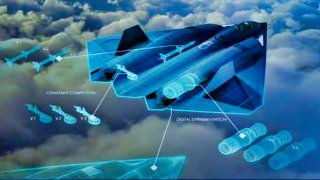X-44 MANTA: The F-22 'On Steroids' Design the Air Force Could Have Built
In the late 1990s, Lockheed Martin's Skunk Works developed the X-44 MANTA (Multi-Axis No-Tail Aircraft), an experimental design based on the F-22 Raptor.
Summary and Key Points: In the late 1990s, Lockheed Martin's Skunk Works developed the X-44 MANTA (Multi-Axis No-Tail Aircraft), an experimental design based on the F-22 Raptor.

-The X-44 aimed to enhance stealth by removing horizontal and vertical stabilizers, reducing the radar cross-section and improving speed and fuel efficiency. It relied on thrust vectoring for maneuverability.
-Despite its innovative design and potential for simplified manufacturing, the program was canceled in 2004 before any test flights. The X-44 MANTA remains a testament to the hidden technological advancements within classified military projects.
The X-44 MANTA: Lockheed Martin’s Ambitious Tailless Fighter That Never Flew
In the late 1990s, as the United States enjoyed a unipolar moment without any real rivals, Lockheed Martin’s renowned Skunk Works began work on an experimental aircraft design. The design was distinct, without horizontal or vertical stabilizers, and it was designated accordingly as the X-44 MANTA (Multi-Axis No-Tail Aircraft).
The X-44 MANTA was developed from Lockheed’s F-22 Raptor, which had recently won the Advanced Tactical Fighter contract. The F-22 was the world's first operational fifth-generation fighter and its first operational stealth fighter.
The X-44 proposed to take the F-22’s stealth elements even further, removing flight surfaces that increased the Raptor’s radar cross section while also improving speed and fuel efficiency by reducing drag. The only problem with removing the flight surfaces, however, was that these are partially what allows the F-22 to yaw, pitch, and roll – to fly, essentially.
Would a tailless variant of the F-22 be able to fly?
X-44 Manta: Testing the tailless aircraft
The X-44 MANTA never got off the ground. The program was canceled in 2004 before making its first test flight, which was scheduled tentatively for 2007. All that remains of the program are a few drawings.
“A patent dated 1996 and belonging to Lockheed has been identified as the real X-44A’s design, or at least very close to it,” The War Zone reported. “The X-44’s skin is supposedly made out of nano-carbon fiber and it’s powered by a Williams F112 turbojet engine.”
The F112 engine is a trustworthy option, already appearing in cruise missiles like the GM-129, and on other unmanned technology demonstrators including the McDonnell Douglas X-36 and the Boeing X-50.
To compensate for the lack of flight surfaces, the X-44 was expected to use thrust vectoring to maneuver. Thrust vectoring is when an aircraft’s engine exhaust nozzle can be adjusted to blow exhaust in different directions. The result is greatly enhanced maneuverability. Of course, thrust vectoring had proven successful on the F-22, but as a supplement to the airframe’s flight surfaces. The X-44 proposed that thrust vectoring alone could be tasked with maneuvering the aircraft – a novel idea.
Part of the appeal of the X-44 MANTA was that the design would have allowed for a relatively simple manufacturing process. The airframe was just an extended delta wing, without tails, making assembly easier than it is for airframes requiring the configuration of several interlocking flight surfaces. The simple fuselage had a delta wing that measured 30 feet. The airframe was modular, with a potato-like fuselage that could have been outfitted with various combinations of sensory equipment. To make transportation simpler, the X-44’s wings likely could have been removeable.

“Above all else, the nearly two decade old X-44A serves a reminder that there is so much technology and history buried in the deeply classified “black” world that we have yet to learn about,” The War Zone writes.
About the Author: Harrison Kass
Harrison Kass is a defense and national security writer with over 1,000 total pieces on issues involving global affairs. An attorney, pilot, guitarist, and minor pro hockey player, Harrison joined the US Air Force as a Pilot Trainee but was medically discharged. Harrison holds a BA from Lake Forest College, a JD from the University of Oregon, and an MA from New York University. Harrison listens to Dokken.
All images are Creative Commons.


